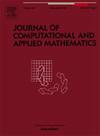Solution of linear ill-posed operator equations by modified truncated singular value expansion
IF 2.1
2区 数学
Q1 MATHEMATICS, APPLIED
Journal of Computational and Applied Mathematics
Pub Date : 2025-03-07
DOI:10.1016/j.cam.2025.116621
引用次数: 0
Abstract
In much of the literature on the solution of linear ill-posed operator equations in a Hilbert space, the operator equation first is discretized, then the discretized operator is regularized, and finally, the computed solution of the regularized discrete problem is projected into a Hilbert space. In order for this solution approach to give an accurate approximate solution, the regularization method has to correspond to a meaningful analogue in Hilbert space. Moreover, the regularization method chosen may only be applicable to certain linear ill-posed operator equations. However, these issues typically are not discussed in the literature on solution methods based on discretization. One approach to circumvent this difficulty is to avoid discretization. This paper describes how regularization by a modified truncated singular value decomposition introduced in Noschese and Reichel (2014) for finite-dimensional problems can be extended to operator equations. In finite dimensions, this regularization method yields approximate solutions of higher quality than standard truncated singular value decomposition. Our analysis in a Hilbert space setting is of practical interest, because the solution method presented avoids the introduction of discretization errors during the solution process, since we compute regularized solutions without discretization by using the program package Chebfun. While this paper focuses on a particular regularization method, the analysis presented and Chebfun also can be applied to other regularization techniques.
线性病态算子方程的修正截断奇异值展开解
在求解Hilbert空间中线性不适定算子方程的文献中,大多数首先对算子方程进行离散化,然后对离散化后的算子进行正则化,最后将正则化后的离散问题的计算解投影到Hilbert空间中。为了使这种求解方法给出精确的近似解,正则化方法必须对应于希尔伯特空间中有意义的类比。此外,所选择的正则化方法可能只适用于某些线性不适定算子方程。然而,这些问题通常没有在文献中讨论基于离散化的求解方法。规避这个困难的一种方法是避免离散化。本文描述了Noschese和Reichel(2014)为有限维问题引入的改进截断奇异值分解的正则化如何扩展到算子方程。在有限维情况下,这种正则化方法产生的近似解比标准截断奇异值分解的解质量更高。我们在Hilbert空间环境中的分析具有实际意义,因为所提出的求解方法避免了在求解过程中引入离散化误差,因为我们使用程序包Chebfun计算正则化解而不进行离散化。虽然本文关注的是一种特定的正则化方法,但所提出的分析和Chebfun也可以应用于其他正则化技术。
本文章由计算机程序翻译,如有差异,请以英文原文为准。
求助全文
约1分钟内获得全文
求助全文
来源期刊
CiteScore
5.40
自引率
4.20%
发文量
437
审稿时长
3.0 months
期刊介绍:
The Journal of Computational and Applied Mathematics publishes original papers of high scientific value in all areas of computational and applied mathematics. The main interest of the Journal is in papers that describe and analyze new computational techniques for solving scientific or engineering problems. Also the improved analysis, including the effectiveness and applicability, of existing methods and algorithms is of importance. The computational efficiency (e.g. the convergence, stability, accuracy, ...) should be proved and illustrated by nontrivial numerical examples. Papers describing only variants of existing methods, without adding significant new computational properties are not of interest.
The audience consists of: applied mathematicians, numerical analysts, computational scientists and engineers.

 求助内容:
求助内容: 应助结果提醒方式:
应助结果提醒方式:


